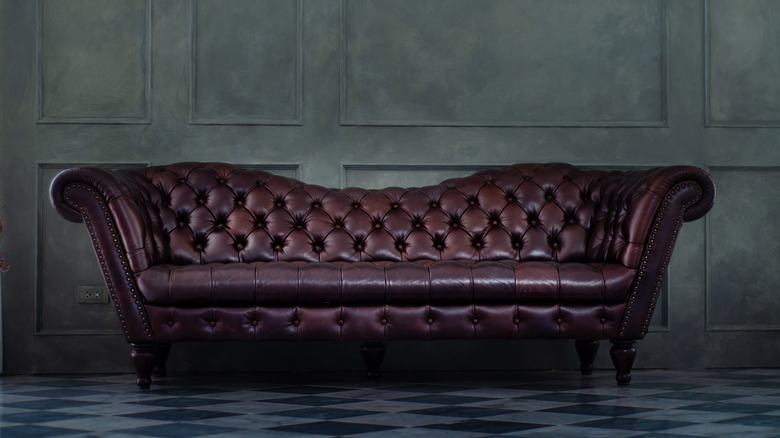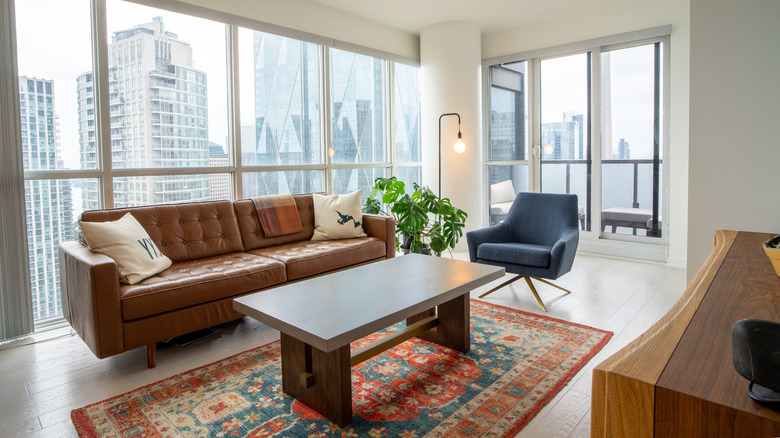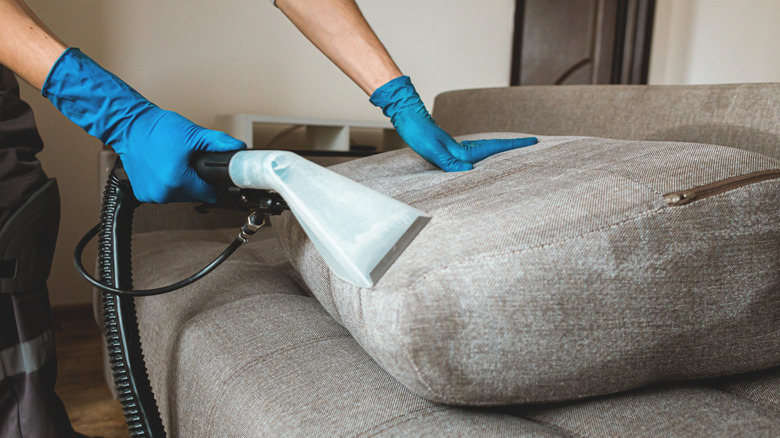Couch Vs. Sofa: What's The Difference?
Sofa and couch are terms often used interchangeably to describe the large, cushioned seating arrangement in a living room, with most people not knowing the difference between the two. So is there even a difference between a couch and a sofa?
According to Southern Living, they are historically two different things. The term couch was initially used for a piece of furniture meant for laying down, while sofas referred to objects intended for sitting. They note that you will less often hear an interior design professional call the furniture we use today a couch. So yes, the terms couch and sofa usually refer to the same thing in casual conversation, but if we're getting technical, there are some differences. It's good to know these differences, no matter how small, so that you know exactly what you're talking about when shopping for your home. This article sheds some light on other differences and tips to get the best out of whichever you have.
How Does The Appearance Differ?
The main difference in appearance between the two is that sofas have backs and armrests, while couches don't always have these features. Couches come in various styles, while sofas are more predictable, always offering you arm and back support. This is why couches are more prevalent in casual, less formal rooms, says Woodstock. If you want a seating area in your space that doesn't have any arms and is ideal for laying down, for example, some couches will meet those needs.
Sofas are more formal seating arrangements. Traditionally sofas were more like cushioned benches with arms and backrests. They're not meant for naps and lounging around. If a couch is a good spot for a movie night, you can think of a sofa as a good center for a cocktail party. They're a comfortable piece for sitting and talking — not so much relaxing and watching TV.
What Are The Differences In Cost?
It's difficult to pinpoint the price difference between couches and sofas because both pieces can range in price drastically, though Homedit says that couches tend to be slightly cheaper. The cost of your couch or sofa will be based on the quality, materials, features, and size. You can find extremely costly sofas — for example, a leather sectional from luxury retailer Mitchell Gold + Bob Williams will cost you nearly $34,000. However, you probably won't need to spend that much to find a quality piece. According to Modsy, you should expect to pay between $1,000 and $2,000.
Are you trying to decide what to budget for a new sofa or couch? Some questions to ponder on include how often you'll need to move and how much use you anticipate it will get, per Modsy. If you plan on staying in the same home and getting a lot of use out of your furniture, it's probably okay to splurge a bit. However, if you're renting an apartment and plan to move from year to year, you'll have to consider moving and storage costs. In this case, it might be best to buy a cheaper piece you can get rid of at the end of your lease.
Pros and Cons of Couches
Because of their casual nature, couches are great for making a house feel like a home. They allow you to just sink into them and relax. A sectional couch can accommodate a large family, while a loveseat couch can allow a small family to feel cozy. Some more advantages of couches are that they are comfortable, great for naps, and more affordable, according to Homedit. They also note that couches are more common in the U.S.
While the pro to couches is that they're incredibly comfortable, it's good to note that they're not as dependable as a bed when it comes to sleep, and it may be good to invest in a piece you won't be so tempted to sleep on. Consistently sleeping on a couch is associated with back and neck problems, according to Healthline. The quality of sleep won't be the best, but they say that if you do have to sleep on a couch regularly, you should invest in sturdy bed pillows and avoid sleeping on throw pillows to avoid neck issues.
Pros and Cons of Sofas
Sofas are great because they are traditional, reliable, easy to obtain, and common all around the world, according to Homedit. Even with the standard composition of the full backrest and armrests, there are various styles to choose from, from tuxedo sofas to pull-out sofas. This allows you to find something that fits your style. They're also more formal since they're meant for sitting and not lounging. If you're having a gathering at your house, it might be better for the guests to have a sturdy seating area rather than one meant for laying down.
On the other hand, sofas are built in ways that are structurally beautiful but maybe not as comfortable as you would like. This can make them less kid-friendly as they are less suitable for play and constant use. If you plan to have friends from out of town crash on your couch from time to time, a sofa won't be the most comfortable option.
Durability and Maintenance
If you have invested in a quality sofa or couch, you should seek professional cleaning to maintain that quality, especially when it's lined with a delicate fabric. This is so you can preserve things like the color and texture as well as possible. If some minor marks or stains form in-between the major cleans, there are gentle spot-cleaning methods that you can do yourself. Ensure the cleaning method you use is suitable for your chair's material. This type of information is usually included in instructions from the manufacturer.
Leather, for example, needs to be kept out of direct heat and treated with conditioning or moisturizing agents, according to LuxDeco. Suede is tough to clean, but stains can be treated with baking soda or vinegar, while velvet is sensitive to cleaning and might need professional assistance, per Maid Right. Some general cleaning methods that can be done regularly include light vacuuming, rotating the cushions to even out the pressure, and using protective covers, says LuxDeco.





